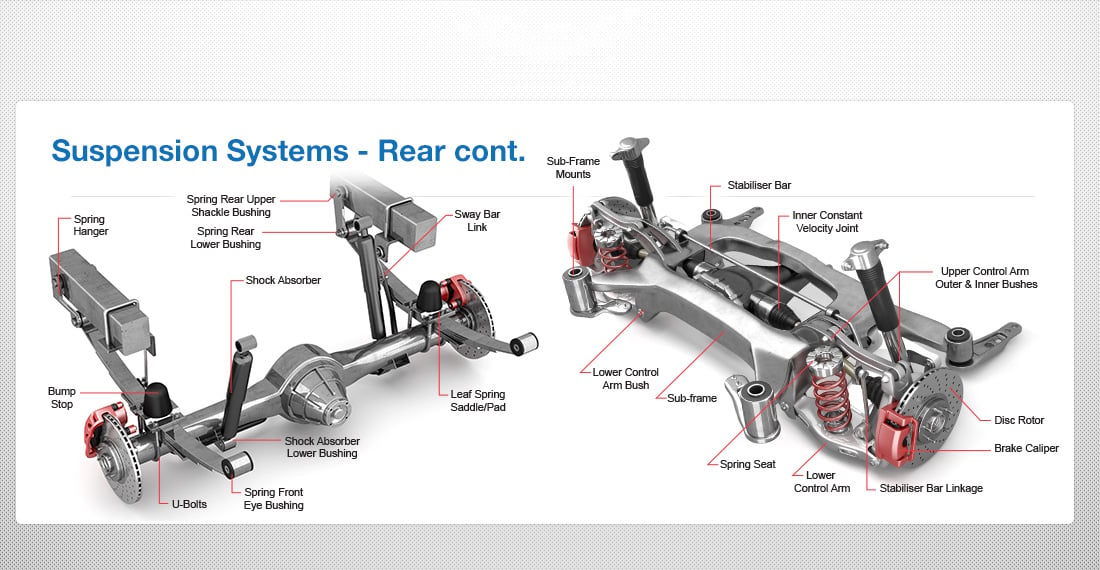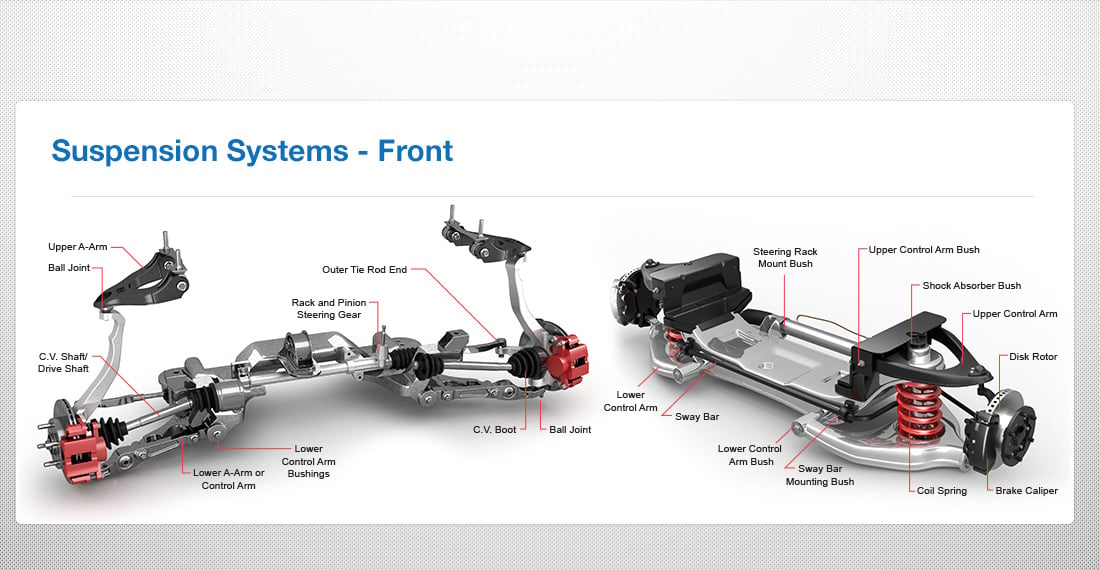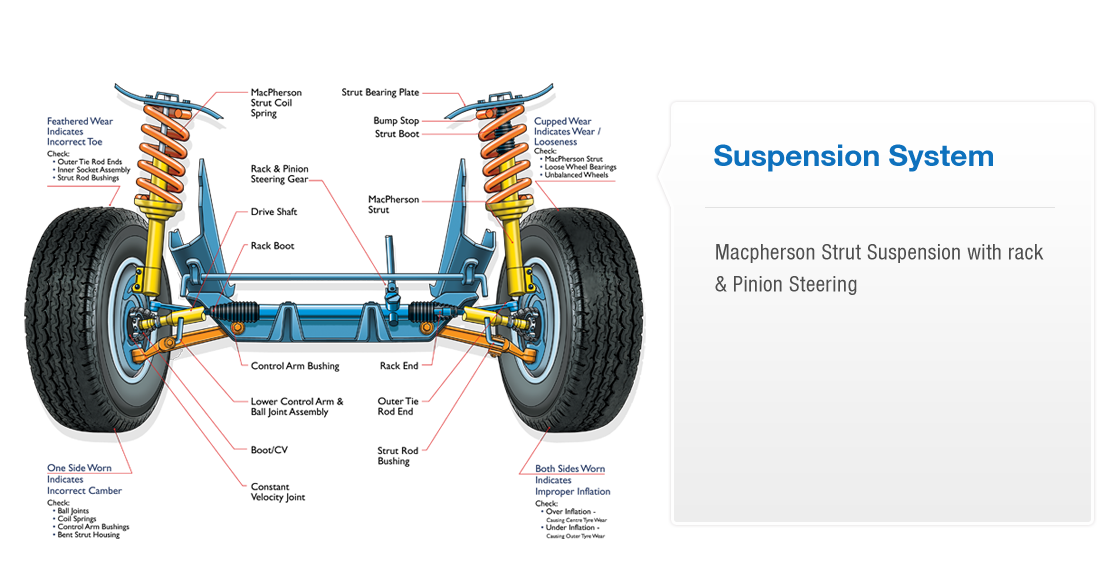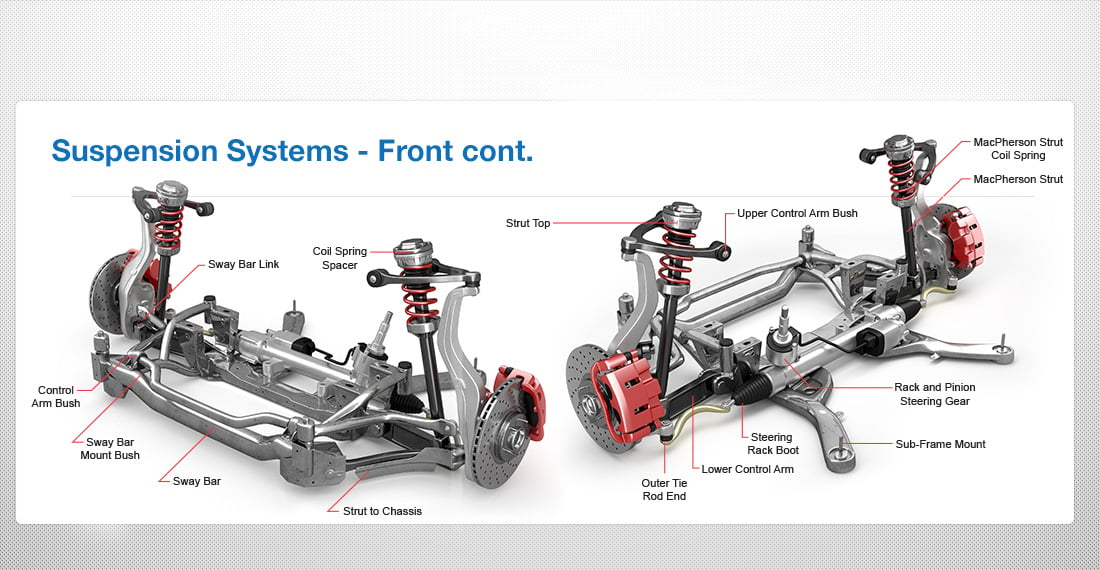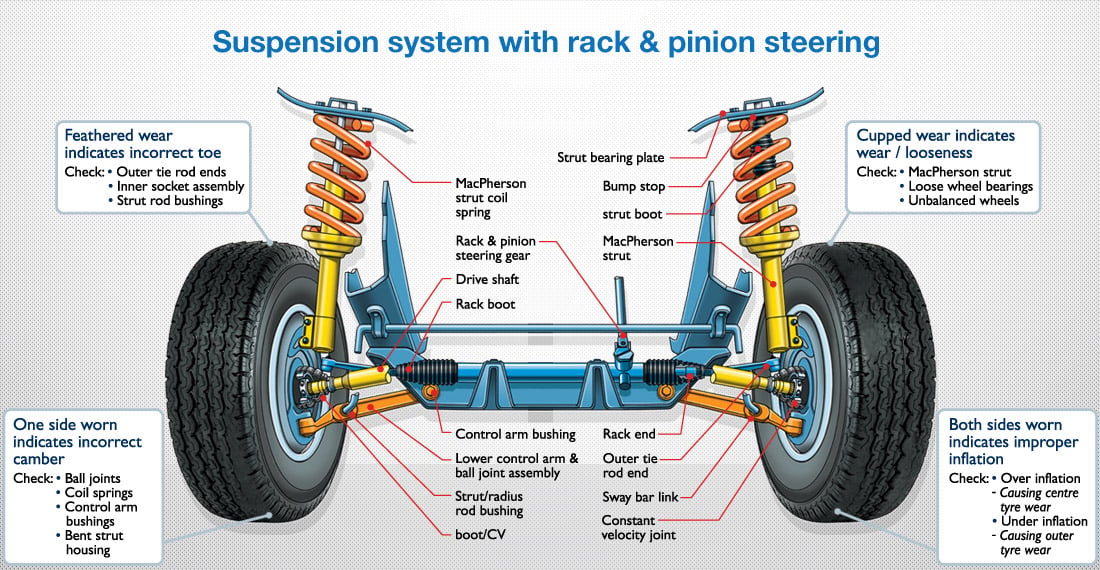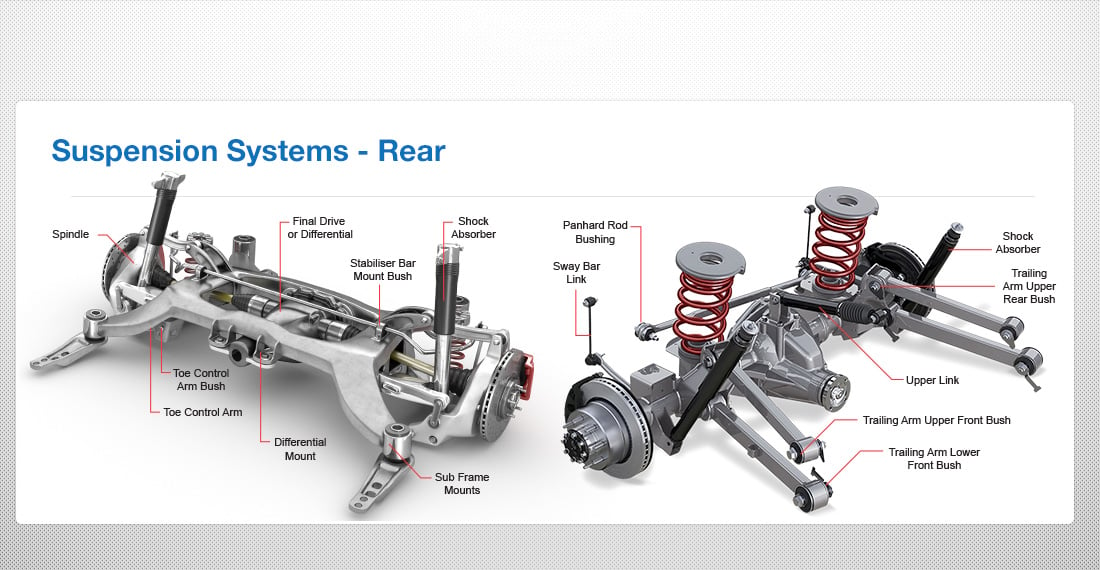
Suspension Repair and Maintenance
If you’re under the impression that a car’s suspension is only responsible for ensuring you have a smooth ride, you’re not alone.
Many drivers think of suspension as a bit of an extra, or add-on, and therefore, they don’t place it at the top of the list when it comes to car maintenance.
Sure, suspension certainly cushions bumps and jolts when driving, but the truth is that it does a lot more than just enhance your comfort.
In fact, your suspension is an intricate system of different pieces and parts.
And each of these components plays an important role in maintaining your car’s performance, reliability, and safety.
If you’re unsure about the importance of suspension repair and maintenance, read on.
What does suspension do for your car?
We all know that your car’s suspension absorbs bumps in the roads, and generally makes for a more comfortable ride, but it does a lot more than that.
Vehicle suspension is actually responsible for ensuring your tyres stay connected with the road which means better grip and braking.
A single worn shock absorber in your suspension system can add up to two metres to the stopping distance of a car travelling at just 50 kmph, which is the width of a pedestrian crossing.
“Your suspension is an intricate system of different pieces and parts…. each plays an important role in maintaining your car’s performance, reliability, and safety.”
Your suspension also enhances your steering for safer, more reliable turning and provides balance during emergency maneuvers which helps to stop your car from rolling.
When your suspension isn’t properly maintained it can also result in faster and more uneven tyre wear, which further compromises safety.
What is a car’s suspension system made up of?
Your car's suspension system is made up of four basic components:
- Struts
- Shock absorbers
- Springs
- Tyres
Shock absorbers and struts are vital for on road safety, performing the function of keeping the tyres evenly connected with the road, and maintaining a vertical load on the tyres.
The springs support the weight of your car, and act as a flexible link that allows the body and frame to ride with minimal disturbance, while the tyres follow the road.
Struts perform two main jobs:
- To generate resistance to force or impact in a similar way to shock absorbers
- To provide structural support for the spring and to hold the tyre in it’s aligned position.
Book in a Vehicle Service at a JAX Tyres & Auto Near Me!
We know how important that your suspension is to the overall performance, comfort and safety of your car.
Badly maintained suspension results in faster and more uneven tyre wear, which further compromises safety.
While, suspension problems can be common, early detection can help prevent more serious issues from occurring. Signs that your suspension isn’t working as it should include:
- Your car feels rough to drive
- You can feel drifting or pulling when you make turns
- You experience a bouncing feeling when driving
- Unusual noises
- Your vehicle nosedives when you brake
Generally speaking, suspension systems are designed to last and will simply wear out slowly due to general use. With proper maintenance and routine inspections, you can expect only minor issues that can usually be quickly fixed. However, there are times when your suspension could fail or collapse suddenly. This can happen as a result of:
- Large bumps: Particularly uneven roads can damage suspension springs or cause them to collapse completely.
- Excess loading: This usually only happens when suspension springs are carrying over the vehicle’s load rating.
- Rust: Since suspension springs are made of steel, over time they can corrode and develop rust. This weakens the strength - of the springs making them more vulnerable to damage and collapse.
The shock absorbers on your car go through as many as one thousand movements per kilometre, so they should be checked every 20,000 kilometres to ensure safe and optimum operation.
You may wish to book in for a suspension check sooner if you:
- Regularly drive over bumps or uneven roads
- Have recently had an accident
- Or you suspect that something isn’t working as it should
“Badly maintained suspension results in faster and more uneven tyre wear, which further compromises safety.”
Like all parts of a car, nothing is made to last forever, and eventually you will need to replace certain parts of your suspension system.
However, if you drive largely on smooth surfaces, have regular checks and maintenance, and if you don’t experience any major impact to your car, your system could function perfectly for up to 100,000 km or longer.
Suspension damage comes in many different forms including: general wear and tear, corrosion, impact damage, or collapse.
It’s not always obvious or apparent when there is damage that could cause issues around safety and performance.
This is why it’s important to have regular checks and if you have any concerns, book in with a professional.
A tyre and auto expert will thoroughly check your suspension system for any issues to avoid any further damage or costly repairs.
If you don't have a well maintained suspension system you are not as safe as you should be, and you could be putting yourself and others at risk.
Suspension repair or replacement can vary depending on what has been damaged and how complex the system is.
Replacing a single set of shocks or struts could take between 2-3hours and have you back on the road in no time. It could take even less if it's a spring or shock absorber.
On the other hand, more widespread issues may take longer. At JAX, our mechanics will carry out a thorough suspension inspection, including all bushes, shocks, struts and other components, to find the root of the cause and get you back on the road safely.
You'll often hear people refer to shocks and struts interchangeably as they are both components that control the ride. However, shocks and struts are two distinct parts with different functions.
Shocks are individual components of the suspension system. Their primary purpose is to control the spring and suspension movement by turning the kinetic energy of suspension movement into heat energy dispersed through the hydraulic fluid.
On the other hand, struts are a major structural component of the chassis and suspension system and perform two main jobs. Firstly, struts perform a damping function like shock absorbers. Still, they also provide structural support for the vehicle suspensions, support the ring, and hold the tyre in an aligned position. By doing so, struts positively affect the ride comfort and handling of your vehicle and its wheel alignment and wear on other suspension components.
Luckily changing your shocks and struts is a relatively easy job if you know what you're doing. In most cases, a professional can repair or change your shocks in hours and have you back on the road quickly.
The basic steps to change the shocks on a car are:
- Have a spring compressor: The shocks and springs are integrated on many modern vehicles, which means you need a compressor to remove the springs.
- Raise the vehicle: To have easy access to get behind the wheels.
- Remove the old shocks: You then remove wheels and then, using a spring compressor, remove the bolts holding the shock in place and remove the shock.
- Install the new shocks: This is usually as simple as reversing what you've done so far. A new absorber is mounted and secured with new bolts.
- Test drive: A quick test drive to check that everything in your car is working correctly.
In general, you should inspect your shock absorbers around every 20,000kms.
Signs that your shocks may need to be repaired or replaced may need attention include:
- Braking issues: As shocks and struts are essential structural components of your suspension system, if damaged, you may find your vehicle lurches forward when you brake, feels unstable or slightly nose dives.
- Steering problems: You may feel your car wandering on the highway, or your steering wheel may feel stiff or difficult to turn.
A bumpy ride: The most obvious sign that your shocks are not working as expected is if your vehicle ride is more uncomfortable than usual. If you lose control when going over a bump or pothole, you likely need to replace or repair your shocks. - Leaking shock fluid
- Uneven tyre wear: When your wheel alignment or suspension is not optimal, your tyres may experience uneven tread wear. This is due to an uneven weight distribution across your four wheels. If you have suspension damage, your tyres will typically have scalloped "dips" or "cups".
The short answer is yes.
An early sign of suspension damage is an unusual noise. This could be in the form of knocking, creaking or clanking coming from the underside of your car. The earlier you identify this problem, the better. A damaged suspension can cause further more severe damage to other parts of your vehicle if not repaired or replaced.
- Knocking: This usually happens when you go over a bump or a pothole. Bumps will cause the coil springs to vibrate against your vehicle chassis.
- Rattling: Rattling could amount to various things depending on other symptoms that go alongside it. If you hear rattling, you should get your vehicle checked.
- Squeaky: This is due to a bad ball joint in your suspension that makes a squeaking noise when your vehicle is going over bumps.
- Groaning: If you hear groaning, grunting or squeaking noise when you go around a sharp turn or over a bump, this is most likely something in your steering mechanism connected to your suspension
The short answer is yes.
When your vehicle's shocks and struts are worn out, it can cause an uneven weight distribution across your tyres, causing the car to bounce. The reduction in road holding force due to the car bouncing will lead to accelerated tyre wear, which causes rubber pieces of the tyre to scallop.

